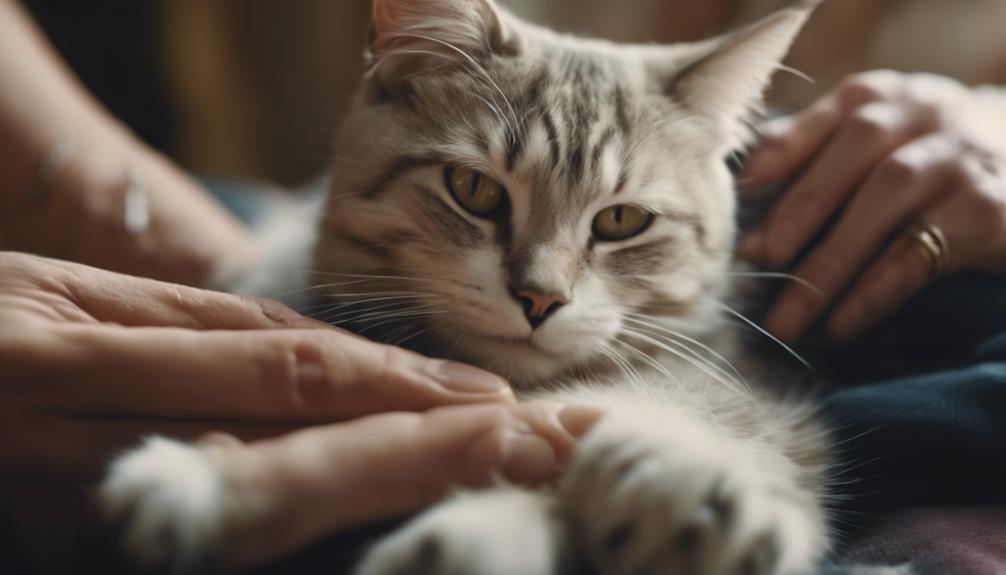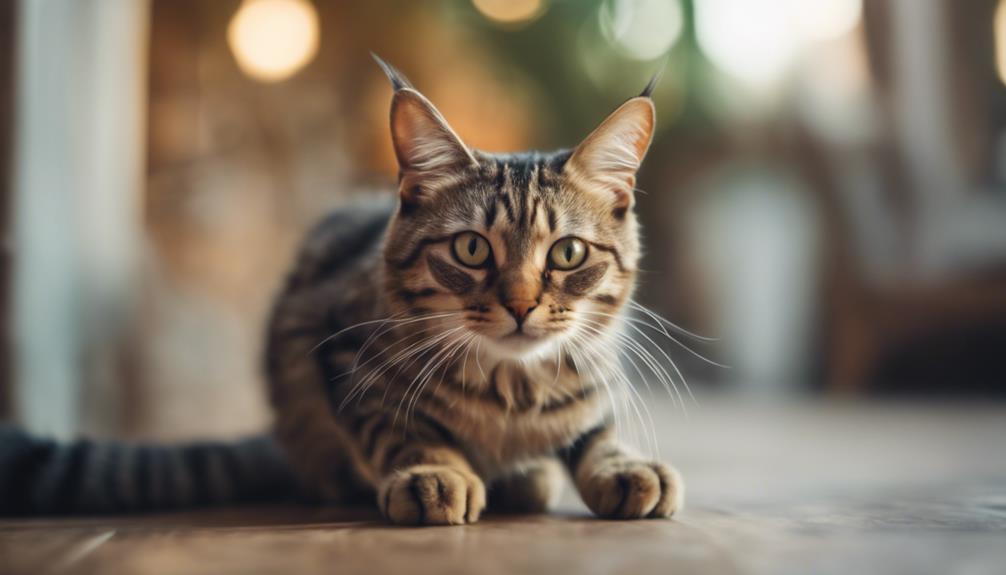In the enigmatic realm of feline communication, deciphering cat body language can be a gateway to understanding our beloved pets on a deeper level. Cats have an intricate system of non-verbal cues that convey a wealth of information about their emotions and needs.
By unraveling the subtleties of their postures, vocalizations, and gestures, pet owners can establish a stronger connection with their furry companions. Learning to interpret these signals not only enhances the human-cat relationship but also enriches the lives of both parties involved.
Key Takeaways
- Cat body language signals stress, fear, hunting instincts, and affection.
- Understanding cat behaviors like marking, swatting, hunting, and affection is crucial.
- Recognizing signs like vocalizing, stalking, headbutting, and purring enhances cat-human communication.
- Observing cues such as tail swishing, dilated pupils, and relaxed body postures aids in interpreting cat emotions.
Understanding Stress and Fear Signs
When noticing a cat's behavior signs of stress and fear, it's crucial to pay attention to various physical and vocal cues they exhibit. These signs may include marking on vertical surfaces, swatting to defend personal space, vocalizing through yowling or hissing, and displaying body language like an arched back, raised hair, dilated pupils, ear movements, and crouching with a tight body.
Cats may also exhibit mature biting in response to pain, panic, or frustration. It's essential to be mindful of sudden environmental changes that could trigger stress or fear in cats. Providing positive attention during stressful situations can help alleviate their anxiety and create a sense of security for the feline companion.
Recognizing Hunting Instinct Behaviors
Recognizing Hunting Instinct Behaviors in cats involves observing their natural predatory tendencies and cues that indicate their readiness to engage in hunting-like behaviors.
Key Indicators:
- Stalking Behavior: Cats may exhibit crouching, staring, and stalking movements when they're in hunting mode.
- Physical Signs: Look for dilated pupils, outstretched whiskers, and butt-wiggling before pouncing, indicating they're preparing to strike.
- Tail Language: A stiff, lowered tail towards the ground, coupled with stiff, raised haunches, suggests your cat is in a hunting stance.
Understanding these behaviors can help cat owners recognize when their feline friends are tapping into their natural instincts to hunt and play.
Interpreting Affection and Attachment Cues

Interpreting a cat's affection and attachment cues involves observing subtle behaviors that indicate their emotional connection with their human companions. Cats display their affection in various ways, such as headbutting, seeking one-on-one time, and purring. Understanding these cues can help strengthen the bond between feline and owner. Here is a table summarizing common affection and attachment cues in cats:
| Behavior | Description | Significance |
|---|---|---|
| Headbutting or Bunting | Rubbing their head against you gently | Indicates trust and affection |
| Seeking One-on-One Time | Preferring individual attention from their owners | Shows a desire for companionship |
| Purring | Producing a soft, continuous rumbling sound | Sign of contentment and happiness |
Decoding Communication Signals
Understanding a cat's body language can provide valuable insights into their thoughts and feelings. Cats use various communication signals to express themselves effectively:
- Tail Position: A cat's tail can convey a lot about its mood. A relaxed or slightly twitching tail indicates contentment, while a puffed-up tail suggests fear or aggression.
- Ear Movements: Cats often move their ears to show their emotions. Ears held forward show interest and curiosity, while ears flattened against the head indicate fear or aggression.
- Purring: Cats purr not only when they're happy but also when they're stressed or in pain. It's essential to consider the context and other body language cues when interpreting a cat's purring.
Cat Noises and Their Meanings

When cats vocalize, they convey various messages through different sounds. Cats use a range of noises to communicate their needs, feelings, and desires. Understanding these sounds can help cat owners better respond to their feline companions. Here is a table detailing some common cat noises and their meanings:
| Noise | Meaning |
|---|---|
| Meow | Request for attention or food |
| Purr | Contentment or relaxation |
| Hiss | Fear, anger, or warning |
| Chirp | Friendly greeting or excitement |
Strengthening the Human-Cat Bond
To foster a stronger bond between humans and their feline companions, engaging in interactive play sessions and providing consistent affection can significantly enhance the relationship. Building trust and understanding can lead to a more fulfilling connection with your cat.
Here are three key ways to strengthen the human-cat bond:
- Interactive Play: Engage in play sessions using toys that mimic prey to satisfy your cat's natural instincts.
- Physical Affection: Regularly pet, groom, and cuddle your cat to show love and care.
- Communication: Pay attention to your cat's body language and vocalizations to better understand their needs and emotions.
Addressing Cat Behavior Challenges

Addressing cat behavior challenges requires patience, observation, and targeted interventions to promote a harmonious relationship between cats and their human companions. Some common behavior challenges include litter box issues, aggression, excessive vocalization, and destructive scratching.
To address litter box problems, ensure the cat's box is clean, accessible, and in a quiet location. Aggression can be managed by identifying triggers and providing positive reinforcement for calm behavior. Excessive vocalization may stem from boredom or medical issues, so enriching the cat's environment and consulting a vet is crucial. Destructive scratching can be redirected by offering appropriate scratching posts and discouraging unwanted behavior gently.
Ensuring Privacy and Data Security
Privacy and data security are essential considerations in safeguarding the information of cat owners and their feline companions. To ensure the protection of sensitive data, individuals can take the following steps:
- Use Secure Platforms: Opt for platforms that prioritize encryption and secure data storage to prevent unauthorized access to personal information.
- Implement Strong Passwords: Create complex passwords and enable two-factor authentication where possible to add an extra layer of security.
- Regularly Update Software: Keep software, apps, and devices up to date with the latest security patches to address any vulnerabilities that could compromise data safety.
Conclusion
As the sun sets and casts a warm glow across the room, the silent language of your feline companion speaks volumes. By tuning into their subtle cues and responding with love and understanding, you can create a symphony of harmony between human and cat.
Embrace the purrs, the whisker twitches, and the gentle headbutts as your cat's way of saying, 'I am here, I trust you, and I love you.' Cherish these moments, for they're the threads that weave the tapestry of your connection.




